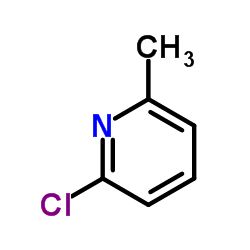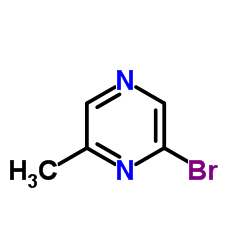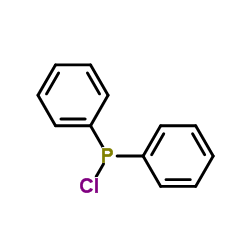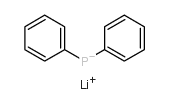2-Diphenylphosphino-6-methylpyridine
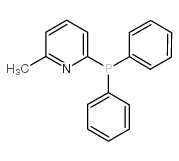
2-Diphenylphosphino-6-methylpyridine structure
|
Common Name | 2-Diphenylphosphino-6-methylpyridine | ||
|---|---|---|---|---|
| CAS Number | 132682-77-0 | Molecular Weight | 277.30000 | |
| Density | N/A | Boiling Point | 390.3ºC at 760 mmHg | |
| Molecular Formula | C18H16NP | Melting Point | 81-83ºC | |
| MSDS | USA | Flash Point | 189.9ºC | |
| Name | 2-Diphenylphosphino-6-methylpyridine |
|---|---|
| Synonym | More Synonyms |
| Boiling Point | 390.3ºC at 760 mmHg |
|---|---|
| Melting Point | 81-83ºC |
| Molecular Formula | C18H16NP |
| Molecular Weight | 277.30000 |
| Flash Point | 189.9ºC |
| Exact Mass | 277.10200 |
| PSA | 26.48000 |
| LogP | 3.14820 |
| Appearance of Characters | crystal | white to off-white |
| Vapour Pressure | 6.01E-06mmHg at 25°C |
|
Section 1: Product Identification Chemical Name:2-Diphenylphosphino-6-methylpyridine, 98% CAS Registry Number:132682-77-0 Formula:C18H16NP EINECS Number:none Chemical Family:organophosphine ligand Synonym:2-Diphenylphosphanyl-6-methyl-pyridine
Section 2: Composition and Information on Ingredients IngredientCAS NumberPercentACGIH (TWA)OSHA (PEL) Title compound132682-77-0100%no datano data Section 3: Hazards Identification Emergency Overview:Irritating to skin, eyes and respiratory tract. May be harmful if swallowed. Primary Routes of Exposure:Inhalation, skin, eyes Eye Contact:Causes moderate irritation of the eyes. Skin Contact:Causes mild to moderate irritation of the skin. Inhalation:Inhalation causes irritation to the nose, mucous membranes and respiratory tract. Ingestion:No specific information is available on the physiological effects of ingestion. Acute Health Affects:Irritating to skin, eyes and respiratory tract. Chronic Health Affects:No information on long-term chronic effects. NTP:No IARC:No OSHA:No SECTION 4: First Aid Measures Immediately flush the eyes with copious amounts of water for at least 10-15 minutes. A victim may need Eye Exposure: assistance in keeping their eye lids open. Get immediate medical attention. Wash the affected area with water. Remove contaminated clothes if necessary. Seek medical assistance if Skin Exposure: irritation persists. Remove the victim to fresh air. Closely monitor the victim for signs of respiratory problems, such as difficulty Inhalation: in breathing, coughing, wheezing, or pain. In such cases seek immediate medical assistance. Seek medical attention immediately. Keep the victim calm. Give the victim water (only if conscious). Induce Ingestion: vomiting only if directed by medical personnel. SECTION 5: Fire Fighting Measures Flash Point:no data Autoignition Temperature:none Explosion Limits:none Extinguishing Medium:carbon dioxide, dry powder or foam. Fire fighters should be equipped with a NIOSH approved positive pressure self-contained breathing apparatus Special Fire Fighting Procedures: and full protective clothing. Hazardous Combustion andIf involved in a fire this material may emit toxic organic fumes and vapors of phosphorus pentoxide. Decomposion Products: Unusual Fire or Explosion Hazards: No unusual fire or explosion hazard. SECTION 6: Accidental Release Measures Small spills can be mixed with vermiculite, sodium carbonate or other suitable non combustible adsorbent and Spill and Leak Procedures: swept up. SECTION 7: Handling and Storage Handling and Storage:Store the material in a cool, dry place in a tightly sealed container. SECTION 8: Exposure Controls and Personal Protection Eye Protection:Always wear approved safety glasses when handling a chemical substance in the laboratory. Skin Protection:Wear protective clothing and gloves. Ventilation:Handle the material in an efficient fume hood. If ventilation is not available a respirator should be worn. The use of respirators requires a Respirator Respirator: Protection Program to be in compliance with 29 CFR 1910.134. Ventilation:Handle the material in an efficient fume hood. Additional Protection:No additional protection required. SECTION 9: Physical and Chemical Properties Color and Form:white to off-white xtl. Molecular Weight:277.3 Melting Point:81-83 ° Boiling Point:no data Vapor Pressure:no data Specific Gravity:no data Odor:not determined Solubility in Water:insoluble SECTION 10: Stability and Reactivity Stability:air and moisture stable Hazardous Polymerization:no hazardous polymerization Conditions to Avoid:none Incompatibility:strong oxidizing agents and halogens Decomposition Products:carbon dioxide, carbon monoxide, organic fumes and phosphorus oxides. SECTION 11: Toxicological Information RTECS Data:No information available in the RTECS files. Carcinogenic Effects:no data Mutagenic Effects:no data Tetratogenic Effects:no data SECTION 12: Ecological Information Ecological Information:No information available SECTION 13: Disposal Considerations Disposal:Dispose of according to federal, state, and local regulations. SECTION 14: Transportation Shipping Name (CFR):Non-hazardous Hazard Class (CFR):NA Additional Hazard Class (CFR):NA Packaging Group (CFR):NA UN ID Number (CFR):NA Shipping Name (IATA):Non-hazardous Hazard Class (IATA):NA Additional Hazard Class (IATA):NA Packaging Group (IATA):NA UN ID Number (IATA):NA SECTION 15: Regulatory Information TSCA:Not listed in the TSCA inventory. SARA (Title 313):Title compound not listed. Second Ingredient:none SECTION 16 - ADDITIONAL INFORMATION N/A |
| Hazard Codes | Xi |
|---|---|
| Risk Phrases | R36/37/38 |
| Safety Phrases | 26-36/37/39 |
| HS Code | 29333990 |
|
~90% 
2-Diphenylphosp... CAS#:132682-77-0 |
| Literature: Grotjahn, Douglas B.; Lev, Daniel A. Journal of the American Chemical Society, 2004 , vol. 126, # 39 p. 12232 - 12233 |
|
~87% 
2-Diphenylphosp... CAS#:132682-77-0 |
| Literature: Li, Yuehui; Lu, Liang-Qiu; Das, Shoubhik; Pisiewicz, Sabine; Junge, Kathrin; Beller, Matthias Journal of the American Chemical Society, 2012 , vol. 134, # 44 p. 18325 - 18329 |
|
~77% 
2-Diphenylphosp... CAS#:132682-77-0 |
| Literature: Shell Oil Company Patent: US5166411 A1, 1992 ; |
|
~91% 
2-Diphenylphosp... CAS#:132682-77-0 |
| Literature: Li, Yuehui; Das, Shoubhik; Zhou, Shaolin; Junge, Kathrin; Beller, Matthias Journal of the American Chemical Society, 2012 , vol. 134, # 23 p. 9727 - 9732 |
|
~66% 
2-Diphenylphosp... CAS#:132682-77-0 |
| Literature: Scrivanti; Beghetto; Matteoli Advanced Synthesis and Catalysis, 2002 , vol. 344, # 5 p. 543 - 547 |
|
~31% 
2-Diphenylphosp... CAS#:132682-77-0 |
| Literature: Chemistry - A European Journal, , vol. 18, # 31 p. 9622 - 9627 |
|
~% 
2-Diphenylphosp... CAS#:132682-77-0 |
| Literature: Inorganic Chemistry, , vol. 52, # 5 p. 2292 - 2305 |
|
~% 
2-Diphenylphosp... CAS#:132682-77-0 |
| Literature: Inorganic Chemistry, , vol. 52, # 5 p. 2292 - 2305 |
| (6-methylpyridin-2-yl)-diphenylphosphane |
